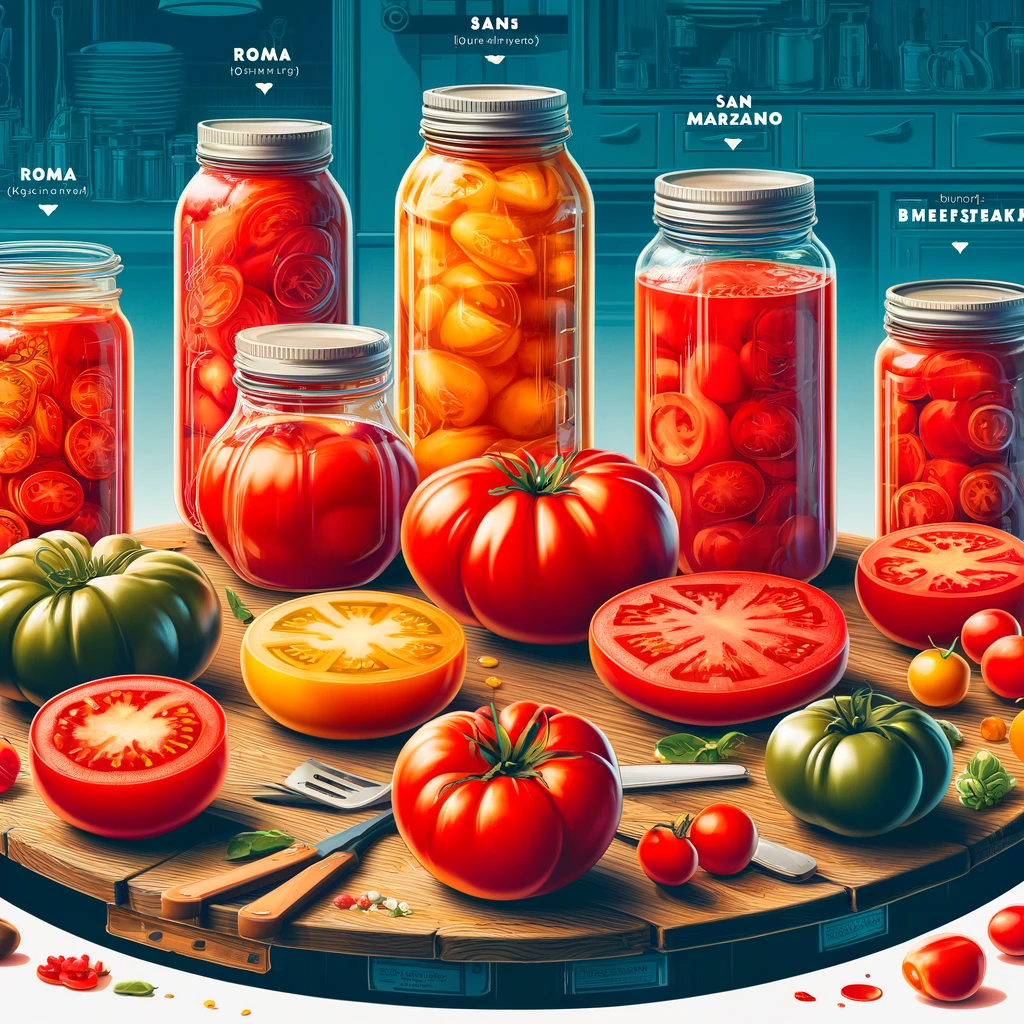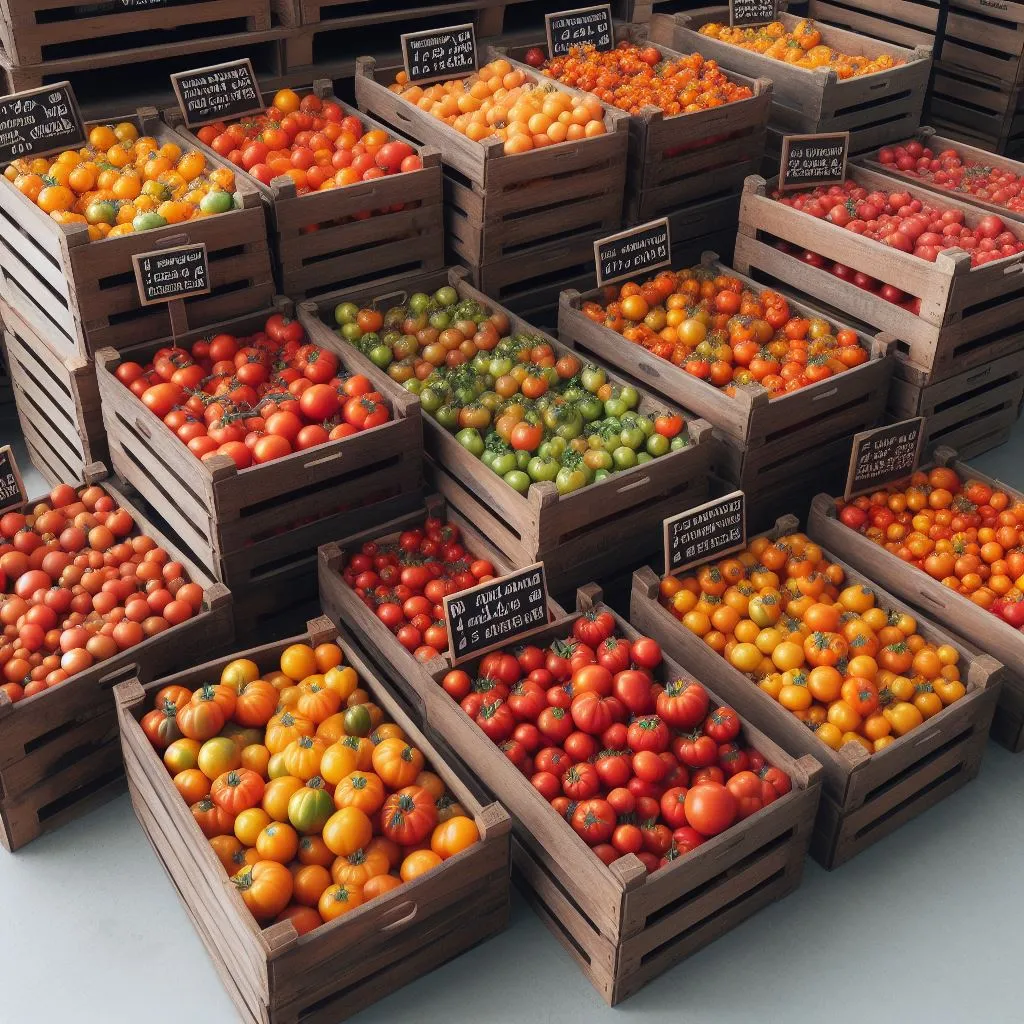For many years, canning produce grown in-house has been a popular pastime. Tomatoes rank among the most often damaged foods in the United States while being the most often canned food.
Let’s face it: most people enjoy seeing tomatoes on the table, in the garden, or on the pantry shelf in a Ball or Mason jar.
After numerous requests and thorough research, I have compiled a list of the best tomatoes to use for canning.
Nowadays, tomatoes come in all rainbow colors and every imaginable shape and size. Their juicy nature makes these varieties so delicious, which adds moisture and flavor to salads or sandwiches but can create extra work and frustration when canning in the kitchen.
At farmers’ markets, most people looking to buy tomatoes for eating fresh are searching for juicy heirloom varieties.
However, this doesn’t mean there aren’t many excellent heirloom tomatoes available for home growers to use in canning. So, what should you do? How can you decide which tomato to grow?
Whole Tomatoes or Tomato Sauce?
It’s important to remember that low moisture content is only crucial when canning tomato sauce and paste. Low-moisture Roma-type tomatoes are the best for making sauce but may lack flavor when canned whole.
Several well-known heirloom tomato varieties are perfect for canning whole, diced, and juice.
Factors to Consider for Sauce Tomatoes:
- Taste
- Low Moisture
- Small Seed Cavities
- High Yielding
- Dependable Yields & Disease Resistance
- Ripening Timetable (spaced out over the season or all at once)
Factors to Consider for Whole or Juice Tomatoes:
- Taste after processing
- Firmness after processing (for whole tomatoes)
- Sized to Fit Jars (for whole tomatoes)
- High Yielding
- Dependable Yields & Disease Resistance
- Ripening Timetable (spaced out over the season or all at once)
What Are the Best Roma Tomato Varieties for Canning?
Roma-type tomatoes have been bred to have small seed cavities and low moisture content, requiring less cooking time to create a thick sauce.
Roma varieties also tend to produce high yields. Their tough but easily removable skin, combined with low moisture, allows them to be stored at room temperature longer than most other tomato varieties. This enables you to accumulate your harvest over several weeks before canning.
Overall, Roma-style tomatoes will give you the highest sauce yield in the shortest time.
If you want to can large quantities of tomato sauce or make your tomato paste, Roma tomatoes are your best option!
Video: Top Tomato Varieties To Grow For Home Canning
The best Roma tomatoes for canning include:
| Tomato Variety | Details |
|---|---|
| San Marzano | These Italian tomatoes are known for their delicious sweet taste, thick flesh, and tiny seed pockets. They’re a traditional favorite in Italy. However, they have low acidity, so make sure to add something acidic like balsamic vinegar or lemon juice to your sauce before canning it (or use a pressure canner for the sauce). San Marzanos are an excellent choice for making tasty sun-dried tomatoes, too. |
| Amish Paste | This thick-walled, meaty heirloom tomato variety originally came from Wisconsin. It produces flavorful tomatoes weighing between 8 to 12 ounces. The plants give high yields; since the tomatoes have low moisture, you’ll get a lot of sauce from them. The downside is that this variety thrives best in Wisconsin’s climate and may not grow well in Arkansas’ conditions. |
| Big Mama | A modern hybrid tomato that grows gigantic paste tomatoes, measuring up to 5 inches long and 3 inches wide. They have low moisture and small seed cavities, meaning you’ll get lots of thick, rich sauce from them. Plus, they have an awesome name that’s fun to say! |
| Golden Mama | This hybrid tomato was specially bred with striking yellow flesh and a mild, sweet flavor. The plants produce heavily so you can make large batches of unique yellow tomato sauce from just a few plants. |
| Viva Italia | Viva Italia is a hybrid variety related to the old-fashioned ‘Roma’ tomato. It grows vigorous plants that yield uniform, meaty, red plum-shaped tomatoes. But these ripen a few days earlier, have better disease resistance, and produce larger fruits (4 to 8 ounces). |
| Plum Dandy | An early-maturing plant that yields firm, sweet, and tasty red plum-shaped tomatoes. They grow in clusters and are resistant to Early Blight disease. Plum Dandy is an outstanding choice for home gardens and market growers since it makes a quality paste and salad tomato. |
Video: Best Tomato Varieties For Canning
What Are the Best Big and Slicing Tomatoes for Canning Sauce?
Large slicing tomatoes from gardens and greenhouses tend to have a lot of moisture inside. This moisture must be cooked before your sauce gets the right thick texture. They also tend to have large seed pockets, and you’ll need to remove the seeds or they’ll make your sauce taste bitter.
But there are four good reasons to use big slicing tomatoes for making sauce:
| Aspect | Details |
|---|---|
| Price | When it’s peak tomato season, local farmers will practically give away cases of them cheap. There are usually way more tomatoes than local stores and markets can sell. |
| Availability | Tomatoes with blemishes or odd shapes can’t be sold at stores since customers only want the perfect ones. But home canners can buy these “imperfect” tomatoes cheaply directly from local farmers, from 20 pounds up to hundreds of pounds. |
| Taste | Certain old-fashioned heirloom tomato varieties give sauces distinct flavours and colours you can’t get from the Roma tomatoes sold at stores. |
| Color | Unique-coloured tomatoes like green zebras can make a cool green sauce, while gold or orange make sauces look neat. |
Here are some of the best beefsteak tomato varieties for canning:
- Ace 55 – These thick-walled tomatoes are tennis ball-sized but stay firm even when cooked, making them perfect for canning whole. They’re low in acid, so add lots of lemon juice if you water bath can.
- Black Krim – A Russian heirloom that produces many unique blackish-purple tomatoes with a rich flavour. The plants get big, so use strong supports. It can be hard to grow heirloom tomatoes in Arkansas’ hot climate.
- Marglobe – In the 1900s, the USDA bred Marglobe tomatoes as the first disease-resistant. People have loved canning them ever since. The plants yield heavily, and all the tomatoes ripen simultaneously, perfect for big canning batches. The Marglobe also makes especially tasty canned tomato juice.
- Rutgers Original – Flavorful, medium-sized 4 to 6-ounce fruits that hold well to canning. It was originally bred from the Marglobe tomato.
Video: The Best Tomato Varieties for Canning Sauce!
What Are the Best Cherry Tomatoes for Canning Sauce?
Cherry tomatoes might seem like a weird choice for sauce since they’re so small and have many seeds inside. But they’re highly productive plants, and the tomatoes are high in sugar and have a pleasant flavour.
If you have a food mill or sieve that can separate the skins and seeds, making a small batch of cherry tomato sauce is worth it just for the novelty of the fresh, sweet taste.
Even a dozen high-yielding plants won’t give you gallons of sauce, but a few pints with that bright cherry tomato zing will liven up any sauce.
Since cherry tomatoes are hard to peel and deseed, use a food strainer to remove the peels and seeds from the pulp easily.
Here are some of the best cherry tomato varieties for canning sauce:
- Supersweet 100 – Named because it produces massive clusters with up to 100 tomatoes each! The high yields mean you can collect enough from just a few plants to make sauce.
- Sungold Cherry – Sungolds are exceptionally sweet golden-orange cherry tomatoes around 1 inch wide. The vigorous, indeterminate plants start producing early and keep going all season. Stake or cage them as they can grow tall. The sweet orange fruits make a unique sauce.
- Yellow Pear Cherry – This heirloom produces tons of bright yellow, pear-shaped cherry tomatoes. They’re very low in moisture for cherries, and ideal for sauce. The “neck” part of the pear is solid flesh with small seed pockets inside, meaning more yellow sauce from each tomato.
- Juliet – Juliet bears deliciously sweet fruit on indeterminate vines. Some gardeners call it a mini Roma because of the shape. The wonderfully sweet, crack-resistant fruit stays in good condition on the plant longer than most cherries.
Add Acid to All Canned Tomatoes
All tomatoes, regardless of variety or method of canning, need to be acidified for safety. Add bottled lemon juice, citric acid, or vinegar to your home-canned tomatoes, sauce, juice, or paste.
To acidify your tomatoes, add 1 tablespoon of bottled lemon juice per pint and 2 tablespoons per quart or 1/4 teaspoon of citric acid per pint and 1/2 teaspoon of citric acid per quart.
Use bottled lemon juice instead of fresh lemon juice to ensure a consistent acidity and add the lemon juice directly to the jar before you add the tomatoes. Tomatoes can also be acidified using vinegar, which may impact your product’s flavor.
These recommendations ensure your tomatoes are safe for home canning so you can enjoy the results of your hard work worry-free!
Tomatoes For Canning Best Resources
- Let’s Preserve: Tomatoes
- Canning Salsa Safely (University of Wisconsin)
- How Do I Can Salsa? (National Center for Home Food Preservation)
- Canning & Freezing Quick Guide: Freezing Vegetables
- How to Freeze Tomatoes Video
- Freezing Raw Tomatoes With and Without Their Skins (University of Nebraska PDF)
Hopefully, this list will give you ideas on whether to grow your tomatoes or shop at farmer’s markets!


